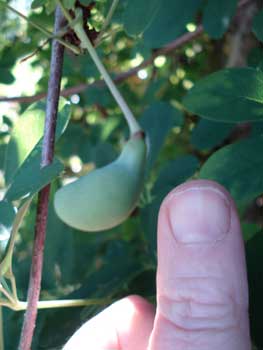 Edible Akebia
Edible Akebia
or Mu Tong Fruit
"I know not if its ancient walls
By vine & moss be overgrown;
I know not if the night-owl calls
From feudal battlements of stone."
-David Starr Jordan
(1851-1931)
(1851-1931)
Akebia vines need to cross-pollinate between different cultivars if they are ever to bear fruit in more than a rare & sporadic manner. Previously we had only one variety of akebia vine ('Albiflorus') planted in two locations (two on an arbor in semi-shade, one on a trellis in direct sun), so there was not much chance of getting them to produce fruit.
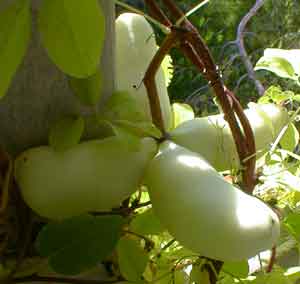 So early in Spring (2002) we added two other cultivars, all three of our varieties being discussed on the Akebia Blossoms Page.
So early in Spring (2002) we added two other cultivars, all three of our varieties being discussed on the Akebia Blossoms Page.Even in the best of conditions it appears not to be possible to cultivate akebias in such a way that they will produce reliable, sizeable harvests that might be grown for profit. Even in its native Korea & Japan where there is a small market for the fruits, they are mainly gathered from the wild rather than as domestic crops.
Though fruiting was not a guarantee even with other varieties to cross-pollinate, & even though we thought the new young vines might require to be in the ground a full year before there'd be a chance of them helping out, in fact all three varieties bloomed simultaneously, & the bees did their job well enough that one of the three older vines produced fruit the same year the other varieties were added, & that same vine has fruited every year since. Some years, as in 2008, the fruit is extremely numerous, but for reasons I can't pinpoint, there are other years, like 2009, when fruits are few.
Though the two arbored akebias grown in a moister & shadier location have grown best in terms of dense leafage & climbing height, it was nevertheless the 'Albiflorus' long planted in a very sunny location that bares fruit, cross-pollinated by 'Silver Bells.' It is surely the sunnier spot that made it our first (& as of 2009 still our only) akebia vine to fruit, but this is also a part of the yard that is the most intensely tended-to by bees of at least three species, plus pollinating wasps & eency teency bee-flies, all of which love best the sunniest flowery locations.
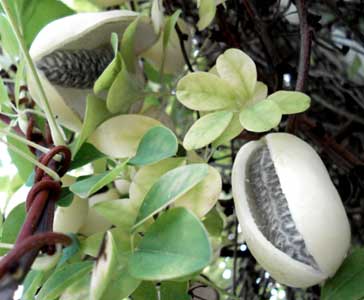 That first year we got fruit, the size was quite a surprise. We'd read they were oblong capsules full of seeds, but I'd never seen a photograph of these seedy fruits nor did any text measure the fruit in inches. I had somehow gotten the idea they'd be fairly small, somewhere between a green grape & a pea pod. Instead they turned out to be bigger than a baby's shoes, sometimes larger. They occur in horizontal "bunches" of two, three, or four capsules.
That first year we got fruit, the size was quite a surprise. We'd read they were oblong capsules full of seeds, but I'd never seen a photograph of these seedy fruits nor did any text measure the fruit in inches. I had somehow gotten the idea they'd be fairly small, somewhere between a green grape & a pea pod. Instead they turned out to be bigger than a baby's shoes, sometimes larger. They occur in horizontal "bunches" of two, three, or four capsules.Also, though we knew they were edible, no source we could find said how to tell when they are ripe & when to harvest them. The fruit was such a pale green, we assumed they must not be ripe. But in fact the pod remained pale green even when fully ripe inside. Fortunately it "told us" when it was ripe by opening itself up.
The first photo up top is of the young fruit getting started in June (2009). These mature in two to three months. The large rather hard capsules burst open late October or more commonly in late September, unfolding -- or "unzipping" -- along the bottom seam.
A university experimental garden website which admitted theirs had not yet bore fruit nevertheless stated that the pods would split open along the top, but that was evidently from misunderstood hearsay; ours definitely opened from underneath, splitting lengthwise. If they had opened at the top, they'd've formed a pair of cups that would've held rainfall, which wouldn't've done the pulp & seeds any good. The split pod revealed a soft whitish transluscent sticky pulp in which shiny black seeds were imbedded.
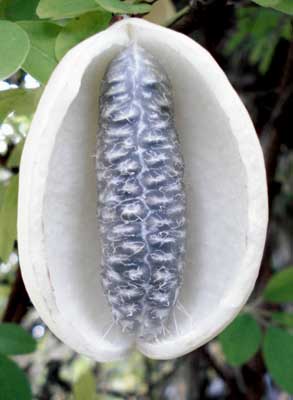 When the pod first cracks open, it reveals what resembles a sack of insect or amphibian eggs. The sticky pulp is at that time at its sweetest, & very pleasant on the pallate, reminiscent of a mild melon-flavored or guava-flavored tapioca.
When the pod first cracks open, it reveals what resembles a sack of insect or amphibian eggs. The sticky pulp is at that time at its sweetest, & very pleasant on the pallate, reminiscent of a mild melon-flavored or guava-flavored tapioca.However, there is not much of the pulp since there is only enough to protect the many densely packed hard shiny black seeds. Two late September photos were taken while standing underneath vines pointing the camera straight up, showing the fruit as it splits open at full ripeness.
The horizontal allignment of the fruit, & their method of zippering open from the bottom, indicates that in nature the pulp drops out of the pods to the ground. If not harvested they will fall to the ground at some point in October, whenever hit by a good hard rain, landing sometimes whole, landing sometimes in three pieces. The October photo below shows precisely where two split pods fell together, but nearby was another pod turned blue with swift rot while its seeds lay two feet away.
The seeds in most cases would not grow where they fall because they cannot compete with the established parent, nor can the seeds be carried on the wind, nor does the pod burst in such a manner as to cast seeds anywhere. They plop straight down to the ground, where insects clean off the pulp & in the process carry seeds to new locations to take root.
Birds may also help disperse seeds but it appears not to be what the vines are striving for. The fruit despite its size can be nearly invisible, green & hidden among the leaves (though only the white-flowered form has whitish to pale green fruit; purple-flowering varieties have showier dusty-violet fruit-capsules). By zippering open on the bottom, only birds that hang upside-down would ever see that the pulpy seeds are finally accessible.
So it seems most likely that insects & small fruit-eating mammals distribute the seeds after they have fallen in one glob from the pod. These are assumptions made from observing its garden habits, because its natural history in the wild has not been much studied & I've encountered no articles on the subject.
The pods themselves are pretty strongly affixed to the vine, & I've even removed the seedy sweet pulp out of the freshly opened pod straight into a bowl without dislodging the emptied pods, which can remain on the vines for their ornamental value. But generally the pods stop hanging onto the branches when the pulp is ready to let loose of the inner hull. The fallen pod-halves very soon turn to mush & rot away in the damp leafmold.
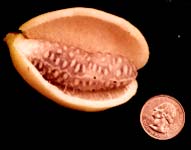 Granny Artemis looked askance at one of these soft sacks of seeds when I held it forth, offering it to her to eat. She exclaimed, "Ewwww, it looks like some kind of caterpillar eggs!" She could barely bring herself to taste the pulp, spitting it out instantly, without giving its flavor a fair chance, complaining in horror: "It's bugs! It's bugs!"
Granny Artemis looked askance at one of these soft sacks of seeds when I held it forth, offering it to her to eat. She exclaimed, "Ewwww, it looks like some kind of caterpillar eggs!" She could barely bring herself to taste the pulp, spitting it out instantly, without giving its flavor a fair chance, complaining in horror: "It's bugs! It's bugs!" 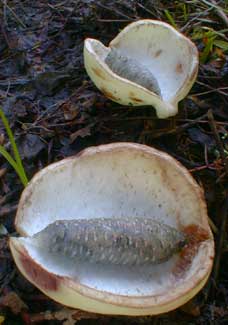 She's not as daring as I am about eating odd things out of the garden (nor as foolish; I've even tasted things alleged to be poisonous). She just couldn't get past the appearance of it being an egg-sack.
She's not as daring as I am about eating odd things out of the garden (nor as foolish; I've even tasted things alleged to be poisonous). She just couldn't get past the appearance of it being an egg-sack.As for me, I was delighted, & have eaten the fruit without qualms. I suck the pulp from the seeds then save the seeds aside to dry. It is not a good idea to chew up the seeds, which are not themselves flavorful & may cause stomach upset.
The main market for the fruit at present appears to be for the Chinese herbal trade, the pulpy sacks of seeds being dried as a single mass, & later processed for powders or extracts. The resultant product is used for treatment of liver & kidney disorders & other ailments, though there is not much likelihood of efficacy, thus one Chinese source recommends extracts from the fruit of any akebia species primarily for "hypochondriac pain." A rare case of honesty in the alternative-medicine trade.
And because the vines don't fruit prolifically, in order to meet the herbal market's needs, akebia stems are often used instead, so that hypochondriacs who believe they're paying for powdered akebia fruit & seeds are actually paying for leaves & twigs, exactly as happens in the west when depressed hypochondriacs buy saint john's wort.
As a fresh fruit, it is easier to eat than a pomegranate which has the same high percentage of seediness. The only reason akebia isn't likely to become a fruit for the produce department of local grocers has less to do with it being predominantly seeds than it being difficult to get the vines to produce well enough to be profitable. Even so, a mild "akebia juice" processed with all seeds removed, I can easily imagine could someday become a gourmet fruit juice product, given that the pulp is uniquely flavorful, Maybe we'll even have Ocean Spray Akebia-Cranberry someday.